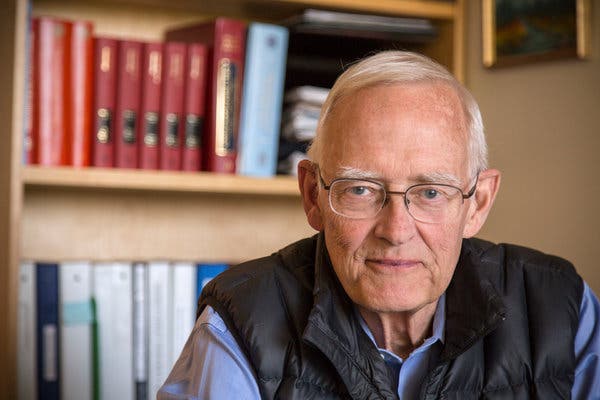Dr. John A. Hansen, an immunologist whose pioneering research made bone marrow transplants safer and vastly expanded the pool of potential donors to patients with leukemia and other blood disorders, died on July 31 at his home in Mercer Island, Wash. He was 76.
The cause was pancreatic cancer, his wife, Suzanne Hansen, said.
As a clinical researcher at the Fred Hutchinson Cancer Research Center in Seattle from 1977 until he retired last year, Dr. Hansen had a profound impact on the treatment of leukemia, lymphoma and blood and immune system diseases.
His team in Seattle developed sophisticated methods of determining which combination of chemicals in a patient’s immune system is required to keep his body from rejecting a marrow transplant from a donor — either a sibling or a complete stranger — whose tissue type does not precisely match.
With Drs. Jeffrey McCullough in Minnesota and Herbert Perkins in San Francisco, Dr. Hansen also helped establish a national registry called bethematch.org, which links patients awaiting transplants with potential donors of bone marrow, blood stem cells and a newborn’s umbilical cord blood.
The registry, operated by the National Marrow Donor Program and authorized by the federal government in 1986, was conceived by a Colorado couple, Dr. Robert Graves and his wife, Sherry.
In 1979, their 10-year-old daughter, Laura, was found to have leukemia. Through Hutchinson she received what was described as the first bone marrow transplant from an unrelated donor for leukemia. The transplant was deemed a success, but her cancer recurred, and she died two years later.
The program says it maintains links to more than 30 million potential donors worldwide.
“The contributions that John made in the field of hematopoietic stem cell transplantation were extraordinary,” Dr. Gary Gilliland, the president and director of the Hutchinson center, said in a statement. “Measured in the number of human lives saved, few physician-scientists have had the impact that he had during his lifetime and will continue to have.”
Dr. Hansen planned to specialize in cardiac surgery after medical school. But he discovered that the nascent field of heart transplantation was being hampered by the tendency of patients’ immune systems to reject the organs.

CreditRobert Hood/The Fred Hutchinson Cancer Research Center
After studying immunology at the University of Minnesota with Dr. Robert A. Good, who had performed the first successful human bone marrow transplant, Dr. Hansen decided to switch specialties. He had recognized, he said, that replacing the body’s immune system held enormous potential for transplantation and treatment in general.
At Hutchinson, Dr. Hansen headed the transplant program’s clinical tissue-typing laboratory; held the titles of senior vice president and director of the Clinical Research Division; ran the Human Immunogenetics Program; and was medical director of the clinical immunogenetics laboratory at Seattle Cancer Care Alliance.
A genetic defect or a disease like leukemia can prevent the marrow — the vascular tissue in the cavities of bones — from producing the right combination of blood cells. In a bone-marrow transplant, a patient’s diseased blood and immune system are replaced with healthy ones from a donor.
To keep the body from rejecting the transplanted marrow, or vice versa, doctors seek to match the marrow type of the donor with that of the recipient as closely as possible. Family members are usually sought, but finding them has become more difficult as couples have fewer children.
Rejection is determined largely by chemicals in the immune system called H.L.A. (human leukocyte group A) antigens, which enable the body to distinguish its own cells from others’.
Dr. Hansen and his team advanced the screening techniques, which were perfected later at other institutions, to expand the universe of acceptable donors. He was part of the team that pioneered bone marrow transplantation, an achievement for which its leader, Dr. E. Donnall Thomas of Hutchinson, shared a Nobel Prize in 1990.
About 1.3 million transplants of blood-forming stem cells or bone marrow have been performed worldwide since 1990.
John Andrew Hansen was born on May 1, 1943, in Minneapolis to Alfred and Ruth (Anderson) Hansen. His father was a Lutheran minister, his mother a nurse.
Dr. Hansen majored in biology at the University of Minnesota and graduated in 1965. He earned his medical degree from Stanford University School of Medicine. He joined Hutchinson in 1977. (Its founder, Dr. William Hutchinson, named it after his brother, the major league pitcher and manager Fred Hutchinson, a Seattle hometown hero who died of cancer in 1964 at 45.)
Dr. Hansen’s first wife, Mary Ann (Wilson) Hansen, died of cancer in the early 1990s. He is survived by three children from that marriage, Eric and Peter Hansen and Connie Jenson; a son, Nicholas, from his marriage to Suzanne Gobeille; and seven grandchildren.

